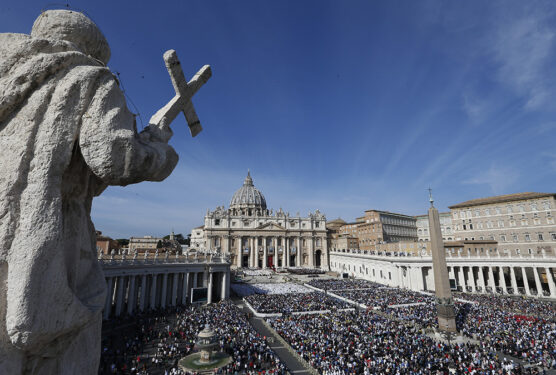
NEW YORK — After Father Peter Mangum anointed a 98-year-old woman who had COVID-19, he couldn’t help but think of five French priests who sacrificed their lives to care for the sick through a yellow fever epidemic in the late nineteenth century.
“When I walk into the room I’m totally scrubbed up, mask, face shield. There she was sitting in a lazy boy chair and she offers me her hand. I’ve been told not to touch her but of course I reach down, took her hand and anointed her,” Father Mangum said.
“When I left and went back to the rectory, I was struck by the fact that I had no way to give a free offering of my life in the situation. I had no fear I was going to die or catch whatever,” he continued.
The Shreveport priest then thought of Fathers Jean Pierre, Narcisse Le Biler, François Le Vézouët, Isidore Quémerias and Louis Marie Gergaud – the French priests who came to Louisiana during the 1873 yellow fever epidemic.
“These knew they were going to die,” Father Mangum said.
In May, Bishop Francis Malone of Shreveport wrote a letter to the Vatican to formally begin the process of making them Servants of God – the first step in the canonization process.
Between late August to mid-November of 1873 Shreveport, Louisiana lost a quarter of its population to yellow fever.
The mosquito-borne disease causes fever, nausea, and muscle pains and can lead to liver and kidney failure.
While people fled Shreveport for safety, Fathers Pierre and Quémerias, who were assigned to the northern Louisiana city, stayed to care for the victims. Father Le Biler, who was chaplain to a local convent, also stayed in the city. Fathers Pierre and Quémerias contracted yellow fever and died. When Father Le Biler came down with the illness, he contacted Father Gergaud – a priest from a nearby town – who arrived in time to give Father Le Biler last rites.
However, Father Gergaud, too, quickly succumbed to the virus. Hearing about the desperate situation, Father LeVezouet then left Natchitoches – then the seat of the diocese – to travel to Shreveport and minister to the sick and dying. He, too, quickly contracted the disease and died.
“The fact that not a single one of them hesitated to stay in an epidemic area where they believed it was person to person transmittable while other people were leaving, the story is above and beyond normal human experience,” said Cheryl White, history professor at Louisiana State University Shreveport in an interview with The Tablet. “It is a willing offering of their lives.”
White, Father Mangum and local historian Ryan Smith have done extensive research on the priests over the past five years. The culmination of that work is a book titled “The Surest Path to Heaven: Shreveport Martyrs of 1873,” with a forward by Archbishop Christophe Pierre, the Apostolic Nuncio to the United States.
Archbishop Pierre is from Brittany, the same region of France as the five priests. They were recruited to come to the United States by Bishop Auguste Marie Martin, the founding bishop of what is now the Diocese of Shreveport.
The French archbishop has prayed at the priests’ tombs in a visit to Shreveport and recognizes the sacrifice they all made. He also recognizes their significance during the COVID-19 crisis.
“Given the challenges that we face in the current pandemic, I believe that the sacrifices of these giants in the faith have a special significance for our time,” Archbishop Pierre wrote. “As a Frenchman and a fellow Brittany priest, I am particularly proud of them and all who have chosen freely to leave their homeland in generous response to their missionary calling.”
White and Smith recognize the parallels between the yellow fever epidemic and the COVID-19 pandemic. However, they also see vast differences in the sacrifice these five priests made.
White points to the medical equipment of the 21st century that the priests didn’t have to keep them safe.
“They had potentially decades more to give to the church and different communities, but this was their calling, and they knew it,” Smith said. “Our current pandemic has heroes, and many of them, but this was something where their days were numbered and they knew they must go.”
The timeline of the story is of particular interest to White. She said there must’ve been divine intervention involved because each priest lived long enough for the next to arrive. Therefore, the city of Shreveport was never left without the sacraments.
Although the story of the five priests is not well known nationwide, it’s been celebrated in Shreveport for nearly 150 years. The French clerics are honored in the stained-glass windows of St. John Berchmans Cathedral and the city’s Pierre Avenue is named after the city’s founding pastor.
Related: Some Say It’s Time to Discern Sainthood for U.S. Women Slain 40 Years Ago
